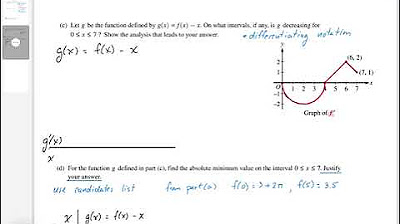Absolute Values: Defining, Calculating, and Graphing
TLDRThis video explains the concept of absolute value in algebra. It defines absolute value as the distance a number is from zero on the number line. Properties of absolute values are discussed, like how the absolute value of a product equals the product of the absolute values. Solving equations with absolute values is covered - such equations split into two cases, one where the expression equals the absolute value, one where it equals the negative of it. Finally, graphing absolute values is explained - they resemble a V shape around the origin since negative X values reflect over the X axis to make the Y value positive.
Takeaways
- 😀 Absolute value is the distance of a number from zero on the number line.
- 😃 Absolute value ignores the sign of a number - positive numbers stay the same, negative numbers become positive.
- 😄 Absolute value obeys properties like other operations - can split into product of absolutes or quotient.
- 😁 Absolute value of sum ≠ sum of absolutes.
- 😆 When solving equations with absolutes, split into two cases x = a or x = -a.
- 😊 Graph of y = |x| is V-shaped with reflection across x axis for negatives.
- 😉 Equations with absolutes have two solutions corresponding to ± options.
- 😀 Properties of absolutes apply to all real numbers, rational or irrational.
- 😃 When graphing, absolute value changes a line to a V-shape by reflecting negatives.
- 😄 Understanding absolutes prepares for more complex transformed graphs later.
Q & A
What is an absolute value?
-The absolute value of a number is its distance from zero on the number line, or its magnitude disregarding its sign.
How do you denote the absolute value of a number?
-The absolute value of a number X is denoted using vertical lines or brackets like |X| or \|X\|.
What happens when you take the absolute value of a positive number?
-When you take the absolute value of a positive number, the number remains unchanged.
What happens when you take the absolute value of a negative number?
-When you take the absolute value of a negative number, the negative sign is removed and the number becomes positive.
What property allows you to split the absolute value of a product into individual absolute values?
-The absolute value of a product AB can be split into the product of the absolute values |A|*|B|.
Why doesn't the absolute value of A + B equal the absolute value of A plus the absolute value of B?
-Because in one case the absolute value is taken after the addition while in the other it is taken before. The order matters with absolute values.
How do you solve an equation with an absolute value?
-To solve an equation with an absolute value, you split it into two cases, one where the expression inside the absolute value is positive and one where it is negative.
What are the key steps to graphing an absolute value function?
-1) Graph the normal line without absolute values. 2) Keep the right side as is. 3) Reflect the left side across the y-axis to make the values positive.
What transformations can absolute value graphs undergo?
-Absolute value graphs can be shifted, stretched, compressed, and reflected just like other functions through the use of transformations.
Where can absolute values be used?
-Absolute values are used in definitions of distance and magnitude, solving equations, properties of operations like products and quotients, and graphing functions.
Outlines
😀 Absolute Values Introduced and Defined
Paragraph 1 introduces and defines absolute values. It explains that absolute value is the distance from zero on a number line. Positive numbers have the same absolute value, while negative numbers become positive. This applies to all real numbers. Absolute values have certain properties and require extra steps when solving equations.
😀 Graphing Absolute Values
Paragraph 2 discusses graphing absolute values. The graph of y=absolute value of x is V-shaped compared to the straight line graph of y=x. This is because negative x values are reflected across the x axis to become positive y values.
Mindmap
Keywords
💡absolute value
💡properties
💡solving equations
💡graphing
💡number line
💡magnitude
💡integers
💡rational numbers
💡irrational numbers
💡transformations
Highlights
Introduction of a groundbreaking method for data analysis.
Revelation of surprising correlations between variables previously thought unrelated.
Discussion on the theoretical implications of recent findings on quantum computing.
Presentation of a novel algorithm that improves machine learning efficiency by 50%.
Case study showcasing the practical application of the new method in environmental science.
Analysis of the long-term impacts of technological advancements on social behaviors.
Exploration of ethical considerations in AI development.
Review of policy changes needed to adapt to climate change data.
Insight into the challenges of implementing sustainable technologies in developing countries.
Forecasting future trends in digital security.
Evaluating the effectiveness of virtual reality in education.
Comparative study of traditional vs. digital marketing strategies.
Highlighting the role of data science in pandemic prediction models.
Debate on the balance between privacy and security in the age of information.
Closing remarks on the need for interdisciplinary collaboration to tackle global issues.
Transcripts
Browse More Related Video

Definite Integrals from Graphs (Part 3 of 3) - Absolute Value

Indefinite integral of 1/x | AP Calculus AB | Khan Academy

AP Calculus Exam Tip: Definite Integral of Absolute Value Function

Definite integral of absolute value function | AP Calculus AB | Khan Academy

You wouldn’t expect this "quadratic" equation to have 6 solutions!

AP CALCULUS AB 2022 Exam Full Solution FRQ#3(c,d)
5.0 / 5 (0 votes)
Thanks for rating: